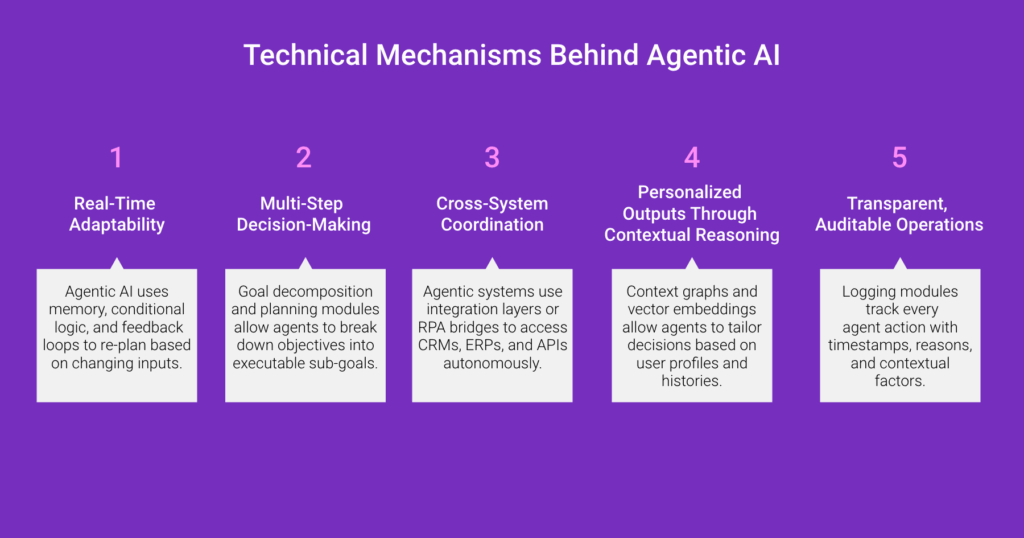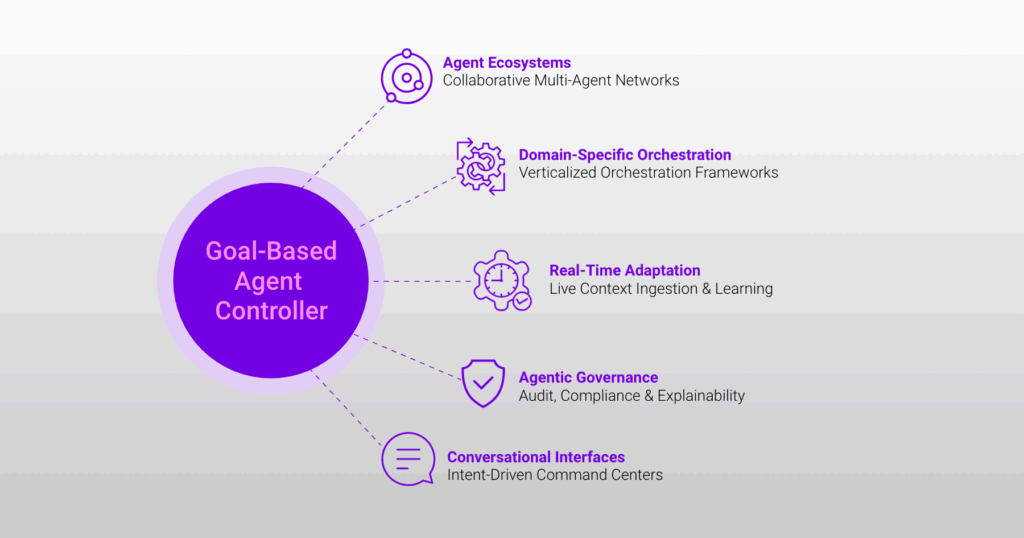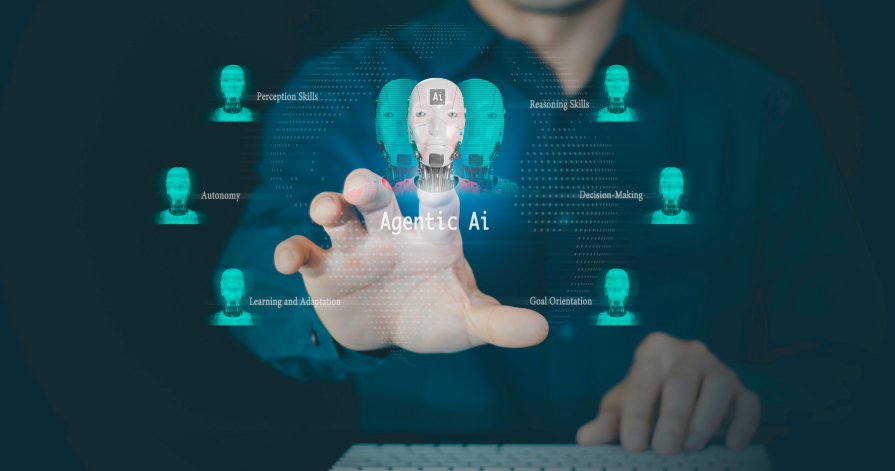Agentic AI integrates intelligence agents to automate routine tasks along with advanced ones.
Agentic AI refers to AI-powered agents that operate autonomously to achieve goals, coordinate across systems, and adapt in real time. Unlike traditional AI, Agentic AI systems are designed to make context-aware decisions with minimal human intervention, transforming automation into proactive, goal-driven execution.
Detailed Definition & Explanation
Agentic AI systems are designed to simulate “agency”, the capacity to act with purpose. These agents don’t passively wait for instructions; they initiate actions based on goals, environmental cues, and evolving context. In enterprise settings, this makes them distinct from static automation or single-function AI tools.
Agentic AI works by combining several foundational components:
- Goal reasoning modules break high-level objectives into dynamic plans.
- Contextual memory tracks progress, history, and external states.
- Tool use interfaces allow the agent to act across APIs, CRMs, databases, and more.
- Feedback-driven learning lets agents course-correct in real time.
- Governance logic ensures agents comply with business rules, ethics, and audit requirements.
These AI capabilities are often enhanced through integration with large language models (LLMs), enabling agents to interpret unstructured inputs and generate content or decisions dynamically.
In multi-agent environments, individual agents communicate, hand off specific tasks, and escalate actions based on confidence thresholds, mirroring how human teams collaborate across complex workflows.
The concept of agentic systems stems from early AI research in cognitive architectures and autonomous agents. In recent years, experimental open-source projects like AutoGPT and BabyAGI popularized the idea, but lacked the oversight and stability needed for enterprise use. The enterprise-grade evolution of Agentic AI focuses on auditability, safe autonomy, and seamless orchestration, bringing the concept into regulated and high-stakes industries.

Why It Matters
- Enables goal-driven decision-making across domains
Agentic AI systems are built to pursue outcomes, not just execute instructions. By embedding reasoning modules and feedback loops, these agents can chart dynamic paths toward objectives. In financial services, this means onboarding agents that adjust compliance steps in real time. In insurance, claims agents can modify routing based on fraud detection or missing documentation.
- Automates complex, repetitive tasks with contextual awareness
Unlike traditional AI or RPA scripts that follow rigid sequences, Agentic AI-powered agents can evaluate context—such as system status, past interaction with users, or policy changes—and decide the next best step. In e-commerce, this allows returns processing agents to identify high-risk items and trigger resolution flows without escalation.
- Improves agent performance over time using real-time data
Agentic AI systems adapt in real time by integrating telemetry, logs, and feedback into memory. This allows agents to refine future decisions or escalate anomalies with greater accuracy. In higher education, tutoring agents adjust content difficulty based on student response patterns, enhancing both engagement and outcomes.
- Supports human-agent collaboration across customer-facing tasks
Agentic AI is not just about full autonomy. It enables intelligence agents to handle customer service inquiries while alerting human agents when nuanced intervention is needed. In consumer services, this reduces wait times, ensures brand tone alignment, and maintains service quality even during peak hours.
- Establishes scalable, compliant automation with minimal human intervention
By integrating business policies and governance constraints into the agent logic, Agentic AI ensures that automated decisions align with enterprise compliance frameworks. In regulated sectors like healthcare or banking, agents can flag, redact, or route sensitive data based on jurisdiction, ensuring responsible AI behavior at scale.

Market Outlook and Real-World Momentum
The shift from tool-based automation to agent-based intelligence is accelerating. The Agentic AI market, which comprises autonomous agents making decisions, planning multi-step tasks, and adapting in real-time, is projected to reach US$ 41.32 billion by 2030. According to Gartner, 33% of enterprise software will incorporate Agentic AI by 2028, a significant jump from less than 1% in 2024. Moreover, about 45% of Fortune 500 companies are already running pilots or early-stage production systems with agentic capabilities, as per a McKinsey report from Q1 2025.
As enterprises move beyond generative AI hype, Agentic AI systems are playing a crucial role in transforming how work gets done. These systems are part of a broader shift toward advanced AI, where autonomous agents leverage both structured and unstructured real-time data to make continuous decisions.
Here are a few real-world examples of Agentic AI:
FD Ryze: As a multi-agent platform for enterprise automation, FD Ryze integrates domain-specific intelligence agents with orchestration layers, audit trails, and real-time feedback loops. In insurance, it powers fraud detection agents that act across claims, policy, and transaction layers. In e-commerce, it automates replatforming by deploying agents that update product taxonomies, sync inventory across APIs, and flag SEO issues—all autonomously. These agentic capabilities make it easier for companies to scale automation without sacrificing control or transparency.
Shopify: Shopify’s Sidekick integrates goal-driven agents into its merchant platform, helping users manage promotions, answer customer questions, and even generate content without prompting—highlighting the practical applications of Agentic AI in commerce.
Visa: Visa has invested in Agentic AI systems that detect fraud, guide remediation actions, and auto-update compliance records in real time, all while minimizing disruption to customer interactions. These examples showcase how integrating Agentic AI unlocks a new paradigm of operational intelligence, speed, and adaptability.
What Lies Ahead
- Agent ecosystems will enable collaborative intelligence at scale
Agentic AI systems will evolve from isolated assistants into coordinated multi-agent ecosystems. Agents will hand off tasks, validate each other’s outputs, and self-organize based on task complexity or risk level. To prepare, enterprises must invest in shared memory layers, agent registries, and dynamic message-passing infrastructure to orchestrate collaboration seamlessly.
- Domain-specific orchestration frameworks will gain traction
Industry-specific agent orchestration layers—preloaded with domain ontologies, regulatory policies, and escalation logic—will become critical to deployment. Financial institutions, for example, will require orchestration that supports AML checks and explainability, while educational systems may prioritize FERPA-compliant data handling. Organizations must align their infrastructure to integrate these policy-aware, verticalized agentic systems.
- Real-time adaptation will become a baseline expectation
Agents will be expected to adapt in real time to data changes, user feedback, and performance metrics, moving away from static automations. This means incorporating vector databases, streaming analytics, and reinforcement learning to build agents that not only react but learn dynamically. Enterprises must build pipelines that capture real-time context and route it into agent behavior loops.
- Agentic AI governance will become a strategic priority
With agents operating semi-independently, organizations will need mechanisms to audit, control, and align agent behavior. Governance frameworks will evolve beyond “red lines” to include continuous compliance scoring, human override layers, and explainability engines. IT and risk teams must design governance-as-code approaches to monitor agent actions, especially in regulated industries.
- Conversational interfaces will become agentic command centers
Natural language interfaces will no longer just answer questions; they will command agentic systems. Business users will ask systems to “launch a new campaign” or “flag at-risk suppliers,” and agent stacks will translate these goals into sequenced actions. Enterprises should invest in training business units to use intent-based interfaces and build prompt governance models to ensure safe command translation.

Related Terms
- Agentic AI Systems
- Multi-Agent Architectures
- Goal-Driven AI
- Context-Aware Automation
